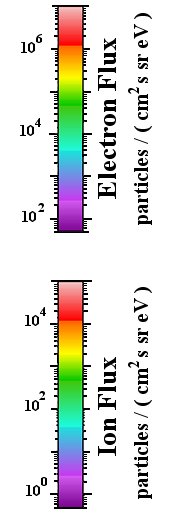 |
The SSJ spectograms are a representation of the differential number
flux or particles per (square-centimeter second ster-radian electron-Volt). The
survey plots DO NOT include a plot of differential ENERGY flux. The conversion
from counts to differential number flux varies from spacecraft to spacecraft,
but the conversion from differential number flux to color is the same for all
spacecraft. If there is a noticeable difference between one spacecraft and
another for the same day, it might be due to errors in the calibration. For
example, the 30 eV to 1 keV ion channels on F15 do not work properly and so the
reported low energy ion flux is much much less than it really is.
Since the number flux of electrons is much higher than the number flux of ions, there
are separate flux-to-color conversion tables for the electrons and
ions.
This color bar is similar but not the same as the color-to-flux
table used in other applications. |
